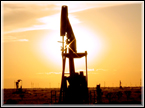Gulf of Mexico: Oil & Gas Industry
 The Gulf of Mexico region contains a third of the remaining known gas reserves and two thirds of the probable gas resource potential in the United States of America. The onshore, shelf and deepwater areas along the Gulf of Mexico produce approximately 45% of the natural gas coming from the Lower 48 states of the United States of America (U.S.).
The Gulf of Mexico region contains a third of the remaining known gas reserves and two thirds of the probable gas resource potential in the United States of America. The onshore, shelf and deepwater areas along the Gulf of Mexico produce approximately 45% of the natural gas coming from the Lower 48 states of the United States of America (U.S.).
Louisiana is the top oil producing state in the United States and ranks second in natural gas production, accounting for an overall 27% of the nation’s daily oil and natural gas. Texas has the second largest crude oil reserves in the United States and ranks second in crude oil production. Texas accounted for 22% of U.S. crude oil proved reserves in 2004.
The continued high price of fossil fuel, in conjunction with the U.S. government’s concerns about the security of the domestic energy supply, has stimulated exploration and development activity in the deep sea environment, which has traditionally been seen as technologically challenging and operationally expensive.
Exploration and development within the deepwater Gulf of Mexico continue to expand, as of March 2006 there were 118 deepwater projects in production.
Potential opportunities exist to provide ocean technologies to the Texas and Louisiana oil and gas industry situated along the Gulf of Mexico.
U.S. oil and gas companies are familiar with Canadian offshore oilfield technology providers and with Canada’s strong reputation for quality and innovation in this area. Companies operating in the region have indicated their interest in Canadian suppliers for equipment and services for the oil and gas industry.
Annual hurricanes have taken their toll on offshore oil rigs in the Gulf of Mexico, which has created an immediate need for a range of products and services aimed at protecting, repairing or replacing damaged structures. Global events such as Hurricanes Katrina and Rita caused devastating destruction along the Gulf Coast and contributed to a disruption of oil and gas production and distribution.
These events have contributed to some of these growth opportunities; however, new entrants will face competition from the network of well-established oil and gas industry suppliers.
The challenge of conducting oil exploration and extraction at depths between 5000–10 000 ft has generated a demand for advanced technological and engineering solutions. Examples include deep-diving remote-controlled vehicles with video-feed capabilities and specialized mooring systems able to withstand the high-pressure deep-sea environment.
In addition, the requirement to remotely monitor rig safety and assure the safety of platform personnel has increased the demand for advanced security solutions (e.g. intrusion detection) and gas leak detectors. Safe, reliable and easily maintained pipeline transmission systems and remote controlled equipment capable of detecting hairline cracks in pipelines are also in demand.
Key Players
A network of well-established suppliers has grown in pace with the oil and gas industry along the Gulf of Mexico. Nevertheless, local agents and product distributors are still in the market for new technologies aimed at increasing efficiency, safety, and production in the offshore environment. Examples of leading dealers/distributors are Mackay Marine and Radio Holland USA, Inc. With their well-established client bases, these experienced firms represent excellent points of entry for the sales process.
Examples of new ocean technologies that have been successfully introduced to the offshore oil and gas industry include vessel monitoring and electronic charting systems (Xanatos Marine), semi-submersible floating production units (FPUs) for ultra deep water (Atlanta Offshore Ltd.) and the first permanent polyester mooring system in Gulf of Mexico, developed by Honeywell.
Local universities and colleges make important contributions to the oil and gas business community in the Gulf of Mexico region, lending expertise to various companies and government organizations. For example, the University of Texas is assisting in offshore platform engineering and research into the long-term effects of harsh weather on oil rigs. Academic contacts can provide valuable information about upcoming technology changes and research being conducted in the field, and may also introduce new entrants to other industry players.
Market Entry Considerations
There is a well-established international supplier network in the region, however given Canada’s reputation for excellence in the offshore drilling environment; many well-established local suppliers have indicated a willingness to partner with Canadian companies to introduce new technologies into the region.
It is particularly important for suppliers with products that require regular troubleshooting and maintenance to partner with a local company that can provide these services on an ongoing basis.
Offering the least expensive product is not necessarily the key to success in this highly regulated market. For example, compliance with stringent international or local standards is required, depending on the product or service in question. These include marine environmental standards. Current information about standards and compliance can also be found on the Web sites of the federal and state regulatory bodies. For most of the largest buyers, there are rigorous internal accreditation and qualification procedures, and these differ company by company. The Canadian Consulate in Houston keeps close to the companies so as to be up-to-date with the necessary contacts for these procedures.
Canadian companies considering the market are advised to contact the Trade Commissioner Service at the Consulate of Canada in Houston for more information about Canadian ocean technology suppliers with a presence in the Gulf of Mexico region.
Excerpts from “The Oil and Gas Market in the Gulf of Mexico (Texas and Louisiana)”, International Trade Canada, November 2006.
You can return to the main Market News page, or press the Back button on your browser.

